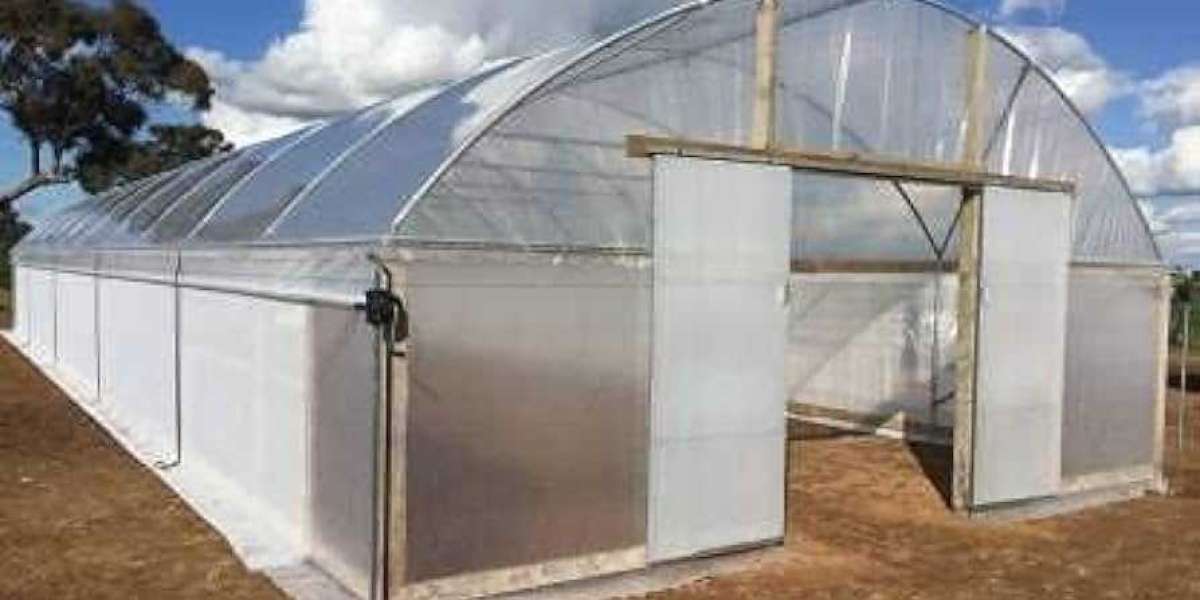In the quest for sustainable agriculture, greenhouse films have emerged as a vital component in the cultivation of crops. These films, often overlooked, play a critical role in enhancing crop yield, protecting plants from environmental stressors, and enabling year-round farming. This blog will explore the significance of Greenhouse plastic manufacturers, their benefits, types, applications, and future trends, providing a comprehensive understanding of why they are indispensable in modern agriculture.
What is Greenhouse Film?
Greenhouse film is a specialized plastic covering used to cover the frames of greenhouses, creating a controlled environment for plant growth. Typically made from polyethylene, these films are designed to transmit light, retain heat, and protect crops from various external elements such as pests, heavy rainfall, and strong winds. The right Greenhouse plastic rolls can significantly influence the microclimate within the structure, promoting optimal conditions for plant growth.
Benefits of Greenhouse Film
1. Enhanced Light Transmission
One of the primary functions of greenhouse films is to ensure that plants receive adequate sunlight. Modern greenhouse films are engineered to allow maximum light transmission while diffusing it evenly. This diffusion reduces shadows and provides a consistent light environment, which is essential for photosynthesis and healthy plant growth.
2. Temperature Regulation
Greenhouse films help in maintaining a stable temperature inside the greenhouse. They act as an insulator, trapping heat during the day and preventing its escape at night. This temperature regulation is crucial for protecting plants from extreme temperature fluctuations, which can be detrimental to their growth and productivity.
3. UV Protection
While plants need sunlight to thrive, excessive exposure to ultraviolet (UV) rays can be harmful. Greenhouse films can be treated to filter out harmful UV rays, protecting the plants from potential damage. This UV protection also benefits the longevity of the film itself, as UV exposure can degrade the plastic over time.
4. Improved Crop Yields
By creating an optimal growing environment, greenhouse films can significantly improve crop yields. The controlled environment reduces the incidence of pests and diseases, minimizes the impact of adverse weather conditions, and extends the growing season, allowing farmers to produce more crops throughout the year.
5. Water Conservation
Greenhouse films contribute to water conservation by reducing evaporation. This is particularly beneficial in arid regions where water resources are scarce. The controlled environment within a greenhouse ensures that water used for irrigation is efficiently utilized, minimizing wastage.
Types of Greenhouse Film
1. Polyethylene (PE) Films
Polyethylene is the most commonly used material for greenhouse films due to its cost-effectiveness and versatility. PE films are available in various thicknesses and can be treated with UV stabilizers to enhance their durability. They are lightweight, easy to install, and provide excellent light transmission.
2. Polyvinyl Chloride (PVC) Films
PVC films are known for their durability and longevity. They offer superior UV protection and are less prone to tearing compared to PE films. However, PVC films are generally more expensive and can be heavier, making installation more challenging.
3. Ethylene Vinyl Acetate (EVA) Films
EVA films combine the benefits of PE and PVC films. They offer excellent light transmission, UV protection, and durability. EVA films are flexible and resistant to cracking, making them ideal for regions with fluctuating temperatures.
4. Polycarbonate (PC) Films
Polycarbonate films are extremely durable and provide excellent light diffusion. They are resistant to impact and can withstand harsh weather conditions, making them suitable for long-term use. However, their higher cost can be a drawback for some growers.
Applications of Greenhouse Film
1. Vegetable and Fruit Cultivation
Greenhouse films are extensively used in the cultivation of vegetables and fruits. They provide a controlled environment that supports the growth of crops like tomatoes, cucumbers, strawberries, and bell peppers. The ability to regulate temperature and humidity levels ensures that these crops can be grown year-round, even in regions with unfavorable climatic conditions.
2. Floriculture
In the floriculture industry, greenhouse films play a crucial role in the production of flowers. The controlled environment provided by the films ensures that flowers can bloom at their best, free from the adverse effects of weather and pests. This is particularly important for high-value flowers like roses, orchids, and tulips.
3. Nursery and Seedling Production
Greenhouse films are vital for nurseries and seedling production. Young plants and seedlings require stable and controlled conditions to develop healthily. The films protect these vulnerable stages of plant growth from external stressors, ensuring a high survival rate and strong, healthy plants.
4. Aquaponics and Hydroponics
Greenhouse films are also used in aquaponic and hydroponic systems, where they help create an optimal growing environment for plants grown without soil. These systems rely on precise control of light, temperature, and humidity, all of which are facilitated by high-quality greenhouse films.
5. Research and Development
Greenhouses equipped with specialized films are used in agricultural research and development. Scientists use these controlled environments to study plant growth, test new varieties, and develop innovative farming techniques. The ability to manipulate environmental conditions precisely makes greenhouse films indispensable in agricultural research.
Installation and Maintenance of Greenhouse Film
1. Installation
The installation of greenhouse film requires careful planning and execution. The frame of the greenhouse should be sturdy and well-prepared to support the film. It is essential to ensure that the film is stretched tightly and secured properly to prevent sagging and tearing. Using appropriate fastening techniques and materials, such as clips and ropes, helps maintain the integrity of the installation.
2. Maintenance
Maintaining greenhouse film involves regular inspections for tears, holes, or any signs of wear and tear. Minor damages should be repaired promptly using repair tapes or patches to prevent further deterioration. Cleaning the film periodically with mild soap and water helps maintain its light transmission properties. Avoid using abrasive cleaners or brushes that could damage the film's surface.
Future Trends in Greenhouse Films
1. Advanced Materials
Research and development in materials science are leading to the creation of advanced greenhouse films with enhanced properties. Innovations include films with improved thermal insulation, increased light diffusion, and greater resistance to UV degradation. These advancements will provide growers with even better tools to optimize their growing environments.
2. Smart Greenhouse Films
The integration of technology into greenhouse films is an emerging trend. Smart films embedded with sensors and automation systems can monitor environmental conditions in real-time. These films can adjust their properties, such as light transmission and shading, based on data inputs, providing a dynamic and responsive growing environment.
3. Sustainable and Biodegradable Films
As the focus on sustainability grows, there is increasing interest in developing biodegradable greenhouse films. These films would reduce plastic waste and environmental impact, aligning with the principles of sustainable agriculture. Research is ongoing to create biodegradable materials that offer the same durability and performance as traditional plastic films.
Conclusion
Greenhouse films are an essential component of modern agriculture, offering numerous benefits that enhance crop production and sustainability. Their ability to create controlled environments, regulate temperature, and protect crops from external elements makes them invaluable for farmers and growers. As technology and materials science continue to advance, the future of greenhouse films looks promising, with innovations that will further optimize agricultural practices and contribute to a more sustainable and productive future. Embracing Greenhouse poly film suppliers from reliable manufacturers like Singhal Industries can revolutionize your farming practices, ensuring higher yields and better crop quality year-round.
Frequently Asked Questions (FAQs):
1. What are the main benefits of using Singhal Industries' greenhouse films compared to other materials?
Singhal Industries' greenhouse films offer numerous benefits, including enhanced light transmission, temperature regulation, and UV protection. These films are designed to allow maximum light diffusion, ensuring that plants receive consistent sunlight essential for photosynthesis. They help maintain a stable internal temperature by trapping heat during the day and preventing its escape at night, protecting plants from extreme temperature fluctuations. Moreover, Singhal Industries' films are treated to filter out harmful UV rays, which not only protects the plants but also prolongs the film's lifespan by preventing plastic degradation.
2. How do Singhal Industries' greenhouse films contribute to sustainable agriculture practices?
Singhal Industries' greenhouse films play a significant role in promoting sustainable agriculture. By providing a controlled environment, these films enable farmers to grow crops year-round, reducing reliance on seasonal cycles and increasing overall crop yield. The films also help conserve water by minimizing evaporation, which is particularly beneficial in arid regions where water resources are scarce. Additionally, by reducing the need for chemical pesticides due to the protective barrier they create, these films contribute to more eco-friendly farming practices. Singhal Industries is committed to developing advanced materials that align with sustainable agriculture principles, further enhancing their environmental benefits.
3. In what specific applications can Singhal Industries' greenhouse films be utilized, and what are their maintenance requirements?
Singhal Industries' greenhouse films are versatile and can be utilized in various applications, including vegetable and fruit cultivation, floriculture, nursery and seedling production, aquaponics, and hydroponics. They provide an optimal growing environment for crops like tomatoes, cucumbers, strawberries, roses, orchids, and many other plants, ensuring year-round production even in regions with unfavorable climatic conditions. Maintaining these films involves regular inspections for any signs of wear and tear, such as holes or tears, and prompt repairs using repair tapes or patches. Periodic cleaning with mild soap and water helps maintain their light transmission properties, ensuring they continue to provide the best possible growing conditions for your plants.








